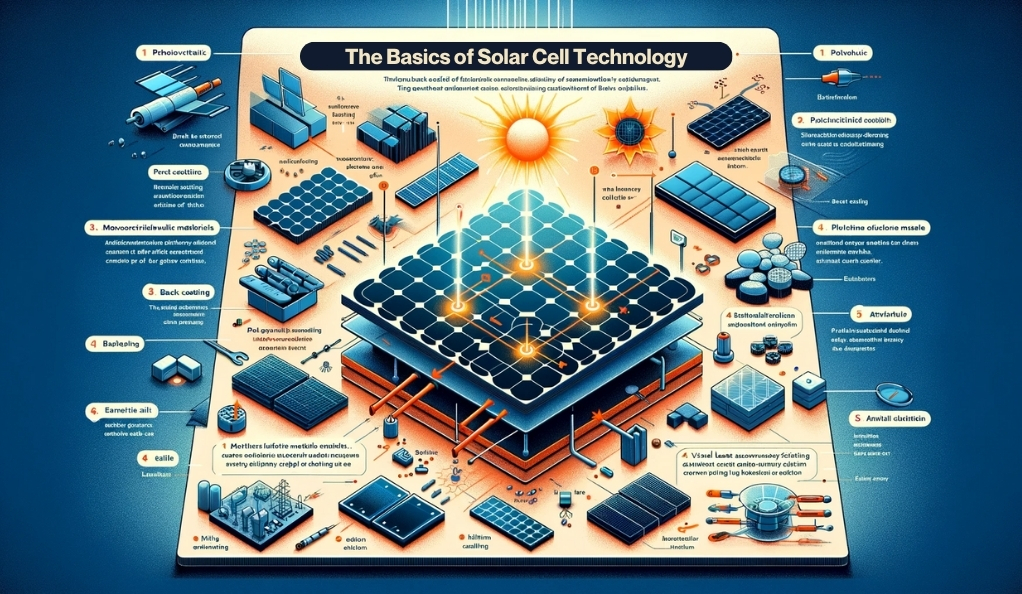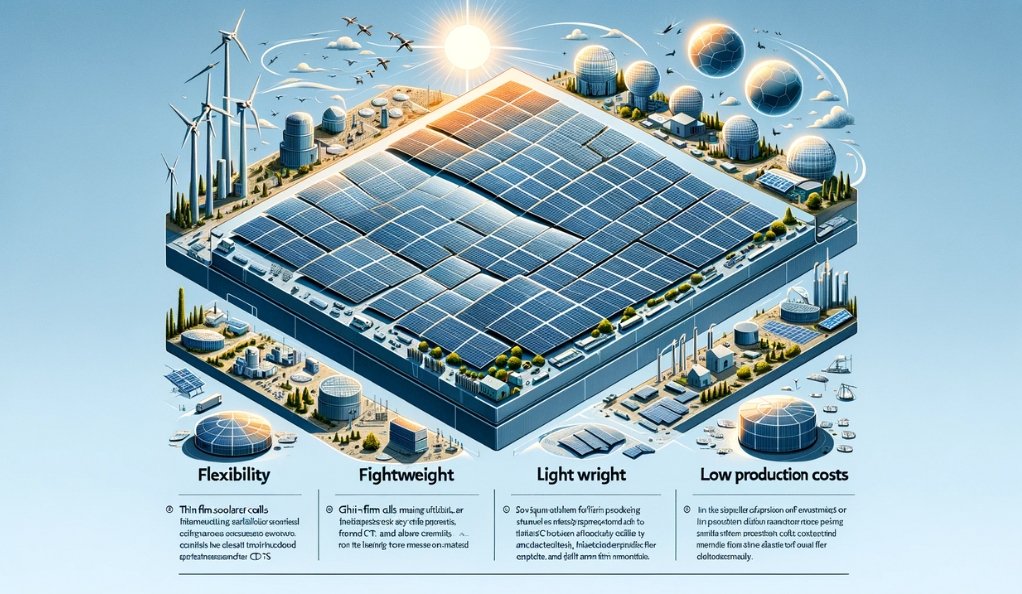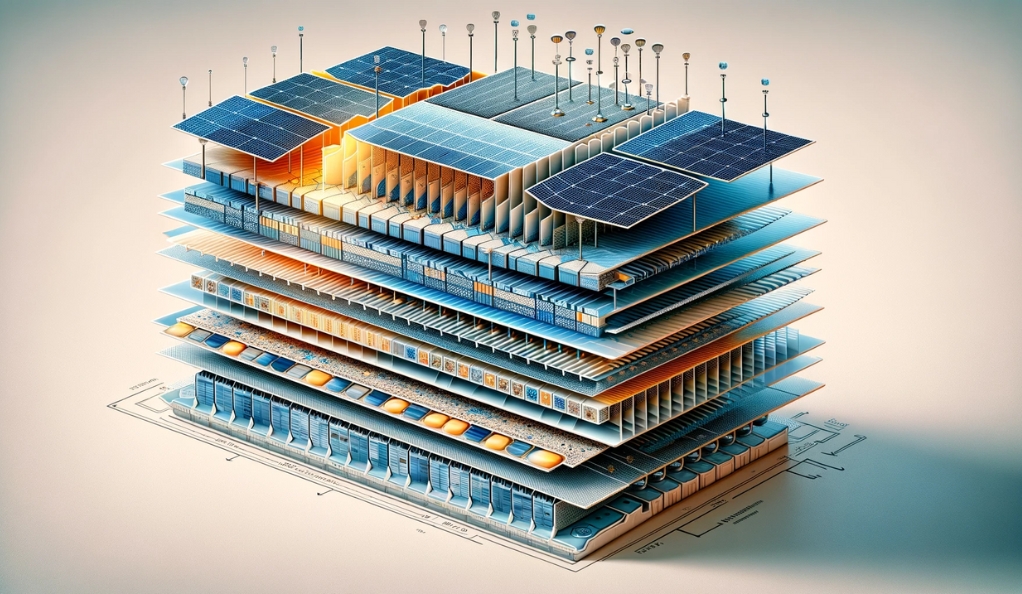In the quest for sustainable and clean energy sources, solar energy stands out as a beacon of hope and innovation. Harnessing the sun’s abundant energy, solar cells have become pivotal in the global shift towards renewable energy. This part explores the fundamentals of solar energy and emphasizes the essential role of solar cells in capturing this renewable source.
The Role of Solar Cells in Renewable Energy
Solar cells, also known as photovoltaic (PV) cells, are the building blocks of solar panels. They are designed to convert sunlight directly into electricity. This process is known as the photovoltaic effect, a phenomenon first observed by French physicist Edmond Becquerel in 1839. Solar cells are made of semiconductor materials, typically silicon, which absorb photons from sunlight and release electrons. These free electrons flow through the material, generating electric current.
What is Solar Energy?
Solar energy is the light and heat radiated from the sun, a colossal fusion reactor in space, providing Earth with a virtually inexhaustible supply of energy. It’s a clean, renewable resource, contrasting sharply with finite, pollution-emitting fossil fuels. The sun’s energy reaches us in the form of solar radiation, which can be converted into electricity or thermal energy.
| Component | Description |
|---|---|
| Semiconductor Layer | Typically silicon, absorbs sunlight and generates electrons. |
| Front and Back Contacts | Conductive layers enabling electron flow into an external circuit. |
| Anti-Reflective Coating | Reduces sunlight reflection, enhancing photon absorption. |
| Glass Cover | Shields the cell from the environment while permitting maximum sunlight penetration. |
Efficiency and Importance
The efficiency of a solar cell is a measure of its ability to convert sunlight into electricity. While traditional solar cells have efficiencies between 15% and 20%, newer technologies are pushing these boundaries further. The importance of solar cells lies not just in their ability to generate clean energy but also in their versatility. They can power anything from small gadgets to entire cities, making them integral to reducing our carbon footprint and combating climate change.
The Basics of Solar Cell Technology

Solar cell technology is a fascinating and rapidly evolving field, central to the global shift towards renewable energy. This part investigates the basic mechanisms of solar cells, illuminating how these remarkable devices transform sunlight into electrical energy.
How Solar Cells Work
The core principle behind solar cells is the photovoltaic effect. When sunlight hits a solar cell, photons (light particles) are absorbed by the semiconductor material, typically silicon. This absorption energizes the silicon atoms, causing them to release electrons. The basic process can be summarized in three steps:
- Absorption of Light: Photons strike and are absorbed by the semiconductor material.
- Generation of Electron-Hole Pairs: Energized electrons are freed from their atomic bonds, leaving behind ‘holes’.
- Flow of Electric Current: An external circuit harnesses this flow of electrons, generating electricity.
Key Components of a Solar Cell
A solar cell’s design is crucial for its efficiency. Here are the key components:
- Semiconductor Layer: The heart of the cell, where light is converted into electricity.
- Front and Back Contacts: These allow the flow of electrons out of the cell.
- Anti-Reflective Coating: Maximizes light absorption by reducing reflection.
- Encapsulation Materials: Protect the cell from environmental factors.
Types of Semiconductor Materials
While silicon is the most common material used in solar cells, there are other types, each with unique properties:
- Monocrystalline Silicon: Offers high efficiency but is relatively expensive.
- Polycrystalline Silicon: Cheaper than monocrystalline but less efficient.
- Thin-Film Materials: Includes amorphous silicon, cadmium telluride, and CIGS (copper indium gallium selenide), known for their flexibility and lower costs.
Efficiency Factors
The efficiency of a solar cell is determined by several factors:
- Material Quality: Higher purity silicon yields better efficiency.
- Light Absorption: Thicker layers absorb more light but can also increase resistance.
- Electrical Configuration: The arrangement of contacts and junctions affects resistance and, therefore, efficiency.
Advancements in Solar Cell Technology
Recent strides in solar cell technology aim to boost efficiency and lower costs. Innovations like Passivated Emitter and Rear Cell (PERC) improve light absorption and electron capture, while Bifacial Solar Cells increase overall efficiency by capturing sunlight from both sides. Tandem Solar Cells merge various materials to capture a wider spectrum of sunlight. A fundamental grasp of solar cell technology is crucial for recognizing their role in renewable energy, as ongoing advancements promise cleaner, more sustainable options for the future.
Monocrystalline Silicon Solar Cells
Monocrystalline silicon solar cells represent the pinnacle of efficiency and performance in the solar industry. This part examines their attributes, effectiveness, and uses, emphasizing why they are frequently regarded as the benchmark in solar technology.
Characteristics of Monocrystalline Silicon
Key characteristics include:
- Appearance: These cells are typically black or very dark blue and have a uniform color, indicating high-purity silicon.
- Material: Made from a single, continuous crystal structure, which reduces the points at which electrons can be disrupted as they flow.
- Efficiency: They are more efficient than their polycrystalline counterparts, often exceeding 20% efficiency in converting sunlight to electricity.
Manufacturing Process
The production of monocrystalline silicon cells involves several steps:
- Czochralski Process: A single silicon crystal is grown from a molten pool of ultra-pure silicon.
- Wafers Cutting: The crystal is then sliced into thin wafers, which form the basis of the solar cells.
- Surface Treatment: Wafers are treated to create the necessary electrical properties and to reduce reflective losses.
Advantages of Monocrystalline Silicon Cells
- High Efficiency: Their single-crystal structure allows for optimal light conversion.
- Durability: They tend to have a longer lifespan, often with warranties of 25 years or more.
- Space Efficiency: Ideal for areas where space is limited, as they generate more power per square foot.
Thin-Film Solar Cells
Thin-film solar cells represent a category of solar technology distinct from crystalline silicon-based cells. In this part, we will explore into the different varieties of thin-film solar cells, their adaptability, and their wide array of applications.
Types of Thin-Film Solar Cells
There are several types, including:
- Amorphous Silicon (a-Si) Thin-Film: This type of cell uses non-crystalline silicon, which allows for flexibility and a lightweight design.
- Cadmium Telluride (CdTe) Thin-Film: CdTe thin-film cells are known for their low production costs and reasonable efficiency.
- Copper Indium Gallium Selenide (CIGS) Thin-Film: CIGS cells offer a good balance of efficiency and flexibility. They are suitable for both residential and commercial applications.
Characteristics and Advantages

- Flexibility: Thin-film cells can be applied to various surfaces, including curved or irregular shapes, making them adaptable to unconventional installation sites.
- Lightweight: Their thin and light construction reduces weight, making them suitable for mobile and off-grid applications.
- Low Production Costs: CdTe and CIGS thin-film cells are known for their cost-effectiveness in large-scale installations.
Efficiency Considerations
While thin-film solar cells offer flexibility and cost advantages, they generally have lower efficiency compared to crystalline silicon cells. Efficiency typically ranges from 10% to 12% for a-Si, 10% to 22% for CdTe, and 10% to 21% for CIGS. However, ongoing research and development are improving the efficiency of thin-film technologies.
Applications
- Building-Integrated Photovoltaics (BIPV): Integration into building materials, such as solar windows or roofing tiles.
- Portable Solar Chargers: Lightweight and flexible, they are ideal for outdoor enthusiasts and remote areas.
- Spacecraft: Thin-film solar cells are used on many spacecraft due to their lightweight properties.
Environmental Considerations
The environmental impact of thin-film solar cells should be considered, as they boast a lower carbon footprint during manufacturing. However, some materials like CdTe contain toxic elements, necessitating proper recycling and disposal. Despite not matching the efficiency of crystalline silicon cells, thin-film technology’s flexibility and cost-effectiveness offer unique advantages for various applications. Ongoing research and development are enhancing their performance, cementing their role in the solar energy landscape.
Emerging Technologies in Solar Cells
The field of solar cell technology is ever-evolving, with ongoing research and development leading to the emergence of innovative materials and designs. In this segment, we will explore two notable emerging technologies in the world of solar cells: perovskite solar cells and organic and dye-sensitized solar cells.
Perovskite Solar Cells
Perovskite solar cells have gained significant attention for their potential to revolutionize the solar industry. They are named after the mineral perovskite, which has a similar crystal structure. These cells are known for their remarkable efficiency and cost-effectiveness.
Key Features of Perovskite Solar Cells
- High Efficiency: Perovskite solar cells have shown the potential to achieve efficiency levels comparable to or even exceeding traditional silicon solar cells.
- Low Production Costs: The manufacturing process for perovskite cells is relatively simple and can be conducted at low temperatures, reducing production costs.
- Flexibility: Similar to thin-film cells, perovskite cells can be made flexible, allowing for innovative design and application possibilities.
Challenges
While perovskite solar cells offer great promise, they also face several challenges:
- Durability: Perovskite materials are sensitive to moisture and can degrade over time, affecting their long-term performance.
- Toxicity: Some perovskite formulations contain lead, raising environmental and health concerns.
Solar Cells Utilizing Organic and Dye-Sensitized Technologies
Organic solar cells and dye-sensitized solar cells (DSSCs) represent another class of emerging solar technologies.
Organic Solar Cells
- Material: Organic solar cells use organic compounds as the semiconductor material.
- Advantages: They are suitable for applications where traditional solar panels may not be feasible.
Dye-Sensitized Solar Cells (DSSCs)
Dye-Sensitized Solar Cells (DSSCs) employ photosensitive dye to emulate plant photosynthesis and capture sunlight. Their unique advantage lies in efficient operation under low light conditions, making them suitable for niche applications like solar-powered backpacks and clothing, where traditional solar cells may struggle to perform effectively.
Challenges
Both organic and DSSC technologies encounter efficiency and stability hurdles, but ongoing research aims to enhance their viability. Emerging solar cell technologies like perovskite, organic, and dye-sensitized cells offer exciting prospects for high efficiency, cost-effectiveness, and unique applications, despite the challenges they must overcome in the pursuit of sustainable energy solutions.
Innovations and Future Trends
The world of solar cells is constantly evolving, driven by innovative research and development efforts. In this part, we’ll explore some of the latest advancements and future trends in solar cell technology, offering a glimpse into what the future holds for renewable energy generation.
Tandem Solar Cells

One of the most significant recent advancements in solar cell technology is the development of tandem solar cells. Tandem cells are constructed by stacking multiple layers of solar cell materials on top of each other, each designed to capture different parts of the solar spectrum. This allows for more efficient energy conversion.
Advantages of Tandem Solar Cells
- Higher Efficiency: Tandem cells can achieve efficiencies beyond what traditional single-junction cells can achieve.
- Versatility: They can be tailored for specific applications, such as indoor lighting or space exploration.
- Improved Performance in Low-Light Conditions: Tandem cells perform well even when sunlight is diffuse or limited.
Perovskite Tandem Solar Cells
Perovskite materials have played a pivotal role in advancing tandem solar cell technology. Researchers have successfully combined perovskite and silicon solar cells to create tandem configurations with remarkable efficiency gains.
Bifacial Solar Cells
Bifacial solar cells are designed to capture sunlight from both the front and rear sides of the panel. They are particularly effective in environments with reflective surfaces, such as snow or water, and can significantly increase energy output.
Advantages of Bifacial Solar Cells
Bifacial solar cells offer increased energy yield by harnessing reflected sunlight, making them a versatile choice for both ground-mounted installations and integration into building designs. Their robust design ensures durability, capable of withstanding various weather conditions, making them a reliable option for solar energy generation.
Beyond Silicon and Perovskite
- Copper Indium Sulfide (CIS): Known for its non-toxicity and high absorption coefficient.
- Quantum Dot Solar Cells: Harnessing quantum dots’ unique properties for increased efficiency.
- Multijunction Solar Cells: Stacking multiple semiconductor materials for improved efficiency.
Environmental Impact and Sustainability
As the adoption of solar cells grows, it is essential to consider their environmental impact and the sustainability of their production, use, and disposal. In this segment, we will explore the lifecycle analysis of different types of solar cells and the steps taken to ensure their environmental responsibility.
Lifecycle Analysis of Solar Cells
A lifecycle analysis (LCA) assesses the environmental impact of a product or technology throughout its entire lifecycle, from raw material extraction to disposal. Solar cells go through several stages:
- Raw Material Extraction: Extracting materials like silicon, cadmium, or perovskite has environmental consequences, including habitat disruption and emissions.
- Manufacturing: Energy-intensive processes for cutting, doping, and assembling solar cells can result in emissions and chemical waste.
- Installation: Solar panel installation can change land use and consume energy.
- Use Phase: Solar cells reduce emissions but efficiency and durability impact their overall environmental impact.
- End-of-Life: Decommissioning and recycling mitigate impacts, while improper disposal can cause pollution.
Sustainability Measures
- Recycling: Recycling programs aim to recover valuable materials from decommissioned solar panels, reducing waste and the need for new resource extraction.
- Material Innovation: Researchers are exploring less environmentally harmful materials and manufacturing processes, such as lead-free perovskite cells.
- Energy Efficiency: Improving the energy efficiency of the manufacturing process can reduce the carbon footprint of solar cell production.
Certifications and Standards
Certification bodies and standards organizations, including ISO 14001 for environmental management, Cradle to Cradle Certified for lifecycle evaluation, and Energy Star for energy efficiency, play a vital role in ensuring the sustainability of solar cell production. Sustainable practices, recycling, and material innovations are crucial for a greener solar energy future.
Conclusion
The realm of solar cells is a dynamic and transformative arena, offering a diverse range of technologies with unique properties and applications. From the high-efficiency monocrystalline silicon cells to the flexibility of thin-film and the potential of emerging technologies like perovskite, the solar industry continues to innovate.
Innovations such as tandem cells and bifacial technology redefine efficiency. As solar energy’s role in global sustainability grows, we must also prioritize the environmental impact of production through lifecycle analysis, recycling, and sustainable practices. This ensures that solar energy benefits extend into a future where clean energy harmonizes with our planet’s well-being, shaping an eco-friendly energy landscape for generations.
